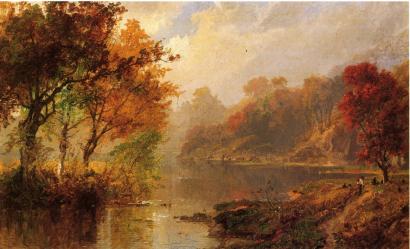Jasper Cropsey
Jasper Cropsey
Signature - 1876
Scarce autograph dated 1876 by one of America’s foremost artists. On 4″ x 5″ lightly and uniformly toned paper. Would frame beautifully with one of Cropsey’s landscapes.

Autumn Landscape, 1876, by Jasper Francis Cropsey
(Completed in the same year he signed this autograph)
JASPER CROPSEY (1823-1900) was an important American landscape artist of the Hudson River School.
Cropsey was born on his father Jacob Rezeau Cropsey’s farm in Rossville on Staten Island, New York, the oldest of eight children. As a young boy, Cropsey had recurring periods of poor health. While absent from school, Cropsey taught himself to draw. His early drawings included architectural sketches and landscapes drawn on notepads and in the margins of his schoolbooks. After studying architecture for five years, he turned his attention to landscape painting, under the instruction of Edward Maury. He visited England, France, Switzerland, and Italy in 1847, went abroad again in 1855, and resided seven years in London, sending his pictures to the Royal Academy and to the International exhibition of 1862.
After his return home in 1863, he opened a studio in New York, where he resided until 1885, when he removed to Hastings-on-Hudson.
Trained as an architect, he set up his own office in 1843. Cropsey studied watercolor and life drawing at the National Academy of Design and first exhibited there in 1844. A year later he was elected an associate member and turned exclusively to landscape painting in the 1840s, shortly after he was featured in an exhibition entitled “Italian Compositions.”
Cropsey married Maria Cooley in May 1847, traveled in Europe from 1847-1849, was elected a full member of the Academy in 1851, and lived in England 1856-1863. During this time he specialized in autumnal landscape paintings of the northeastern United States, often idealized and with vivid colors. One such painting is “The Valley of the Wyoming” set in eastern Pennsylvania. The name of this valley was given to the western state of Wyoming.
Cropsey’s interest in architecture continued throughout his life and was a strong influence in his painting, most evident in his precise arrangement and outline of forms. But Cropsey was best known for his lavish use of color and, as a first-generation member from the Hudson River School, painted autumn landscapes that startled viewers with their boldness and brilliance. As an artist, he believed landscapes were the highest art form and that nature was a direct manifestation of God. He also felt a patriotic affiliation with nature and saw his paintings as depicting the rugged and unspoiled qualities of America.
Some of his works include “Jedburgh Abbey”; “Pontaine Marshes” (1847); “Backwoods of America” (1857); “Richmond Hill” (1862); “Greenwood Lake” (1870); “Lake Nemi in Italy” (1879); “Old Church at Arreton, Isle of Wight” (1880); “Ramapo Valley” (1881); “Autumn on the Hudson” (1882): “Wawayanda Valley” (1883); “Spring-time in England” (1884); “October in Ramapo Valley” (1885); “Autumn on Lake George,” and “A Showery Day” (1886).
Jasper Cropsey died in anonymity but was rediscovered by galleries and collectors in the 1960s. Today, Cropsey’s paintings are found in most major American museums, including the National Gallery of Art, the Metropolitan Museum of Art, the Los Angeles County Museum of Art, the Timken Museum of Art in San Diego, the Honolulu Academy of Arts, the Fine Arts Museums of San Francisco, the Denver Art Museum, and the Museum of Fine Arts, Boston. Works by Cropsey also hang in the White House.
All Vintage Memorabilia autographs are unconditionally guaranteed to be genuine. This guarantee applies to refund of the purchase price, and is without time limit to the original purchaser. A written and signed Guarantee to that effect accompanies each item we sell.

